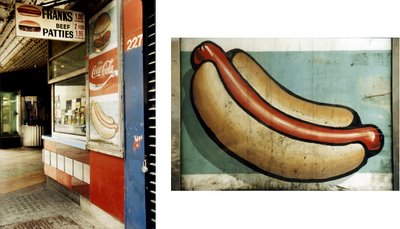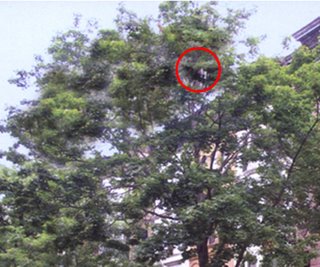
7.26.2006
7.20.2006
authenticity?
 Obvious, perhaps, and reductive, but something seemed to fall into place when I was in Times Square last week:
Obvious, perhaps, and reductive, but something seemed to fall into place when I was in Times Square last week:I suppose I'm one of those people who really annoys other more “pragmatic” people by taking issue with the renewal of Times Square, specifically the main stretch of 42nd Street. Adam Gopnik in the New Yorker went all Pete Hamill in ‘04, in describing this certain ‘affliction’:
There are, of course, people who miss the old Times Square, its picturesque squalor and violence and misery and exploitation. Those who pointed at the old Times Square as an instance of everything that capitalism can do wrong now point to the new Times Square as an instance of everything that capitalism can do worse. ...they end up being sentimental about anything, shedding tears about muggings and the shards of crack vials glittering like diamonds in the gutter.Um, no. When I worked at the New York Public Library on Fifth Avenue and 42nd, I would occasionally walk over to TS and was witness to its last long death spiral, from about 1990 to 1995. Its absolutely not that I liked the old Times Square or enjoyed the experience of having to brave drifters, hustlers, and the generally creepy electricity of the place. It didn't seem as though I had the much editorialized nostalgie de la boue. But rather, I think, the layering of signs, styles, architecture, shine, grit, old and new, the fleeting and the hold-out was, at very least, organic. It was built by use, if that makes any sense. What bothers me so much about 42nd street today is the sham "spectacle," the enforced antic gaiety of it all. The subway entrances are especially irksome, and empty, gestures. I'd had trouble reconciling my feelings about the old and the new Times Square and it bothered me that I couldn't quite define my opinion. I think its as simplistic as this: bad “authenticity” trumps bad “renewal.”
[I took this image of one of the 8th avenue subway entrances in around 1994. In relation to this view, behind me and to the left, there was a small arcade with two video games, a photobooth and an ancient “fortune telling” machine that I recall being something like this one. When I last went to that photobooth, it was, like the area around it, just about to give up the ghost. It spit out photo strips for free but because the developing fluid was shot the images were obscured by a disturbing black...miasma. For a moment while posting this I wondered why I didnt take more photos--I dont have any of the arcade. Then I remembered that, in the old TS, with my big honkin' camera around my neck, I was too nervous!]
Labels:
architecture,
best of,
new york,
nostalgia/remembrance,
photograph(y)
7.17.2006
shady business



Yesterday, Robert and I braved searing midday sun and muddled activist foment in Grand Army Plaza, doing our part to flesh out the slightly disappointing (as of about 2:45-ish) crowd at the Develop Don't Destroy anti- Ratner rally. Robert was generally game; I hollered and razzed at the appropriate moments, and bought a button. We signed lists, commiserated a bit with other outraged but heat-stricken neighbors, took some fliers and then fled to shadier areas to rest and review the literature. The brochure has the obvious but effective juxtaposition of Gehry-Ratner waking nightmare and leafy Prospect Heights streetscape. But wait--what's this? Inexplicably, someone at DDD actually thought it would be a good idea to up the contrast between the two scenarios by Photoshopping in more trees. There's even a stray bit of cloned building hovering, wraithlike, in the air (circled). Didn't we all just go through the outrage over Ratner's fudged renderings and deceptive advertorials? "Which of these is your Brooklyn?" Evidently neither!
7.11.2006
dreaming in translation
I woke up the other day saying, “lipsmitten.” It was absolutely clear to me: spelling, pronunciation, meaning. One word. Lipsmitten. It means enjoying the sound of a word, independent and regardless of its meaning. As an aside, I have to say I dont actually like the sound or the look of "lipsmitten." (I find the word "smitten" irritating, and the assonance of the i's is dopey)
So why or how I coined this particular word is a psychological mystery. And irony.
Even more intriguing to me is the sense that "lipsmitten" sounds like its the translation into English of a foreign term. As if English were my second (dreaming) language. A possible clue is that in an earlier post I mentioned wanting a German term for "obvious but insightful" and of course 'lipsmitten' sounds german (cue audio: "lip • shmitt'n"). But I know no real German, only Germanesque terms used as comic asides or pidgin Germanesque ("Guinea Porken"). I am preoccupied by English's (?) dearth of terms for psychological/philosophical/verbal nuances, so maybe i just made up my own. "Yah, Gut!"
So why or how I coined this particular word is a psychological mystery. And irony.
Even more intriguing to me is the sense that "lipsmitten" sounds like its the translation into English of a foreign term. As if English were my second (dreaming) language. A possible clue is that in an earlier post I mentioned wanting a German term for "obvious but insightful" and of course 'lipsmitten' sounds german (cue audio: "lip • shmitt'n"). But I know no real German, only Germanesque terms used as comic asides or pidgin Germanesque ("Guinea Porken"). I am preoccupied by English's (?) dearth of terms for psychological/philosophical/verbal nuances, so maybe i just made up my own. "Yah, Gut!"
7.10.2006
the past is a foreign country


I love that quote, though I have to admit I know nothing about its author, L P Hartley. My past is a foreign country and in this particular image from my past, above, I’m in a foreign country (I’m in the middle, a rotund little American on the scrawny little camel). But it is less foreign to me than the image of the disgruntled car seat passenger in Flushing, Queens. I have no specific recollection of either moment (though I do remember quite a lot from the Egypt trip) but it is the Queens image that seems like an artifact to me. You’d think that the trip photo, being in black and white, would feel all the more distant-- in time, place, and representation. Instead its the foreignness of the car-- the full width seat, the plastic, the triangular vent window, the crudeness of the car seat, and quaintness of my outfit that strike me. Its the really forgettable, everyday details that change imperceptibly that somehow become so...memorable.
From the bits and pieces I've read (I know a little about a lot of things, which is not only dangerous, it makes for confusing blog entries) about Viktor Shlovsky’s concept of defamiliarization, i think it's very much related:
The technique of art is to make objects ‘unfamiliar’, to make forms difficult, to increase the difficulty and length of perception because the process of perception is an aesthetic end in itself and must be prolonged. Art is a way of experiencing the artfulness of an object; the object is not important." (Shklovsky, “Art as Technique”)The active intent present in "Art" -making is not there, but the effect is similar. In this case its the distance of time that increases the “length of perception.” Simply looking at an image of “the past” --random family snapshot or historical view-- allows one to “experience the artfulness of an object” if you're open to seeing it.
7.09.2006
“inexhaustibility”
By chance I came across this obvious but supremely insightful comment (there must be some fabulous German term I need to know meaning “obvious, but insightful”) by one Russell Davies, designer: “One of the things I hate about the design of most things ... is they're all designed to be new.” This immediately brought a number of thoughts together for me. It encapsulates the problem I have with a good deal of bad Modernist architecture, especially those of the Brutalist persuasion. I've hated Brutalism from the moment I set eyes on this particular building. When I 'knew' it, the building was about 25+ years old and was a disaster to be in and around. Corbusier and Rudolph, et al., had envisioned a gleaming Utopia. Unfortunately the bloom is off that “radiant” rose. Modernism in general and brutalism in particular do not age well--stained and chipped concrete just do not belong in Utopia!
One of the comments with Davies' post about the process of 'things aging gracefully' mentions the Japanese terms wabi and sabi. I learned of these a few years ago and was astonished (and oddly relieved) to have found a definition (a codification!) of the vague aesthetic ideas and ideals that I held but never pieced together and could never explain satisfactorily. Growing up, I often related to things around me as "the farthest thing" from what I would find appealing. What I was, what I liked, was opposite to a large part of what I found around me. (This was Queens in the 1970s and 80s, which explains a lot, and I will return to that in another post .)
Here is a quote from Andrew Juniper on wabi and sabi:
One of the comments with Davies' post about the process of 'things aging gracefully' mentions the Japanese terms wabi and sabi. I learned of these a few years ago and was astonished (and oddly relieved) to have found a definition (a codification!) of the vague aesthetic ideas and ideals that I held but never pieced together and could never explain satisfactorily. Growing up, I often related to things around me as "the farthest thing" from what I would find appealing. What I was, what I liked, was opposite to a large part of what I found around me. (This was Queens in the 1970s and 80s, which explains a lot, and I will return to that in another post .)
Here is a quote from Andrew Juniper on wabi and sabi:
The term wabi-sabi suggests such qualities as impermanence, humility, asymmetry, and imperfection. These underlying principles are diametrically opposed to those of their Western counterparts, whose values are rooted in the Hellenic worldview....an aesthetic sensibility that finds a melancholic beauty in the impermanence of all things.Another essay about w-s I just read today adds in the term "inexhaustibility" saying, "the object resounds ... with endless possibilities and nuances, at once hidden and successively revealed." That goes far in describing some of what I felt at Ellis Island in 1976, and explicating the sense of loss upon my return after the renovation. Ruins (which I think deserve their own post) embody w-s. I think it makes sense to me now.
7.01.2006
hearing things

 This is the Ellis Island in 1976; at top is some forgotten room, bottom, the main waiting hall. I was eleven, on a special viewing of the place with my parents and I had my little Instamatic camera along. We were taking part in a dedication ceremony marking the beginning of the restoration effort. These are the only 2 images I have from that day. I remember seeing a lot of random discarded furniture in empty rooms, and vines covering windows and actually creeping into the interior along one passageway. Every step reverberated. I thought I could feel the past in the rooms.
This is the Ellis Island in 1976; at top is some forgotten room, bottom, the main waiting hall. I was eleven, on a special viewing of the place with my parents and I had my little Instamatic camera along. We were taking part in a dedication ceremony marking the beginning of the restoration effort. These are the only 2 images I have from that day. I remember seeing a lot of random discarded furniture in empty rooms, and vines covering windows and actually creeping into the interior along one passageway. Every step reverberated. I thought I could feel the past in the rooms.I went looking for these because I recently purchased "The Destruction of Lower Manhattan" by Danny Lyon. Roaming the blocks of the lower west side that were being razed (1966-67) to make way for the World Trade Center, Lyon darted in and out of buildings, documenting the dereliction and subsequent demolition. The images-- the whole book-- is pretty loose. His commentary has a "wow, man, far out" sensibility (because it was the 60s and he was high on peyote a good deal of the time) but nevertheless there is something he was feeling (perhaps because he was high on peyote a lot at the time...) that really resonates with me. This peculiar metaphysical, almost spiritual quality of connection-- independent of time. Of being able to hear something in the buildings themselves, as though the beams and plaster could communicate through the intervening years, to you, right now.
Labels:
architecture,
new york,
nostalgia/remembrance,
pathos,
photograph(y),
ruins
Subscribe to:
Comments (Atom)



